| Oracle® Fusion Middleware User's Guide for Oracle Business Intelligence Discoverer Plus 11g Release 1 (11.1.1) B40105-01 |
|
 Previous |
 Next |
| Oracle® Fusion Middleware User's Guide for Oracle Business Intelligence Discoverer Plus 11g Release 1 (11.1.1) B40105-01 |
|
 Previous |
 Next |
This chapter explains how to create graphs in Discoverer Plus Relational to answer typical business questions, and contains the following topics:
A Discoverer graph is an interactive pictorial representation of worksheet data. If is often easier to analyze trends in your data using a graph. The example below shows a three-dimensional bar graph of profit figures for regions.
Note: In the example above, the underlined axis labels (that is, Centre, East, West) are links that enable you to drill down into the graph. For example, clicking on the West underlined axis label drills down to data for cities in the West region (for example, Seattle, San Francisco).
Discoverer provides a wide range of graphs to help you analyze data visually (for example, area, bar, line, and scatter graph). For a complete list of graph types available in Discoverer, see "About graph types available in Discoverer".
Each Discoverer worksheet can have one graph. You create a graph for the items currently displayed on a worksheet. Before you create a graph, ensure that you display the numeric worksheet values you want to plot on the graph.
You can drill up and down in a Discoverer graph in the same way as you can drill in a worksheet (for more information, see "How to drill up and down").
Discoverer provides the Edit Graph dialog to help you create and edit graphs (see Figure 8-2).
The Edit Graph dialog helps you:
choose a graph type and a graph style
choose the data you want to represent in a graph
specify how the graph looks
If you change the data displayed in a worksheet, the graph automatically updates to show the new data.
Once you have created a graph, you can edit the graph using the Edit Graph dialog, or edit areas of the graph using the Graph toolbar and right-click menus (for more information, see "How to edit a graph").
You can hide and display a worksheet graph (for more information, see "How to hide and display a graph").
When you save a workbook, Discoverer saves graphs automatically for you as part of the worksheets in the workbook. In other words, you do not have to explicitly save graphs.
Notes:
To edit a Discoverer graph, you must use the same Discoverer tool that you used to create the graph. In other words:
if you created a graph using Discoverer Plus Relational, you must use Discoverer Plus Relational to edit the graph
if you created a graph using Discoverer Desktop, you must use Discoverer Desktop to edit or view the graph
Graphs created in Discoverer Plus Relational can be viewed in Discoverer Plus Relational, Discoverer Viewer, and Discoverer portlets.
Graphs created in Discoverer Desktop can only be viewed in Discoverer Desktop.
A worksheet can have both a Discoverer Plus Relational graph and a Discoverer Desktop graph saved with the worksheet.
When you print a worksheet with a graph in Discoverer Plus Relational, the worksheet and graph print on separate pages. For more information about how to print a worksheet and graph on the same page, see "About printing in Discoverer Plus Relational".
Discoverer gives you great flexibility when producing graphs, enabling you to configure every component of a graph. The figure below shows the typical components of a Discoverer graph.
Discoverer enables you to change the font of each graph component.
To present your worksheet data visually in Discoverer, you can choose from a wide range of graph types. For example:
bar graph
line graph
pie graph
Each graph type has one or more variations, or sub-types. For example, the sub-types for the Bar graph type include the following:
Bar
Dual-Y Bar
Percent
Some graphs also have dual-Y sub-types, which have two Y-axes. Dual-Y graphs are useful for showing the following types of data:
data of different measures (such as region sales on the Y1-axis and profit on the Y2-axis)
data of different scales (such as sales on the Y1-axis and percent of total sales on the Y2-axis)
The table below shows the graph types that are available in Discoverer.
| Graph icon | Graph category and description |
|---|---|
 |
Area - graphs to show trends or changes in data using filled-in areas. This graph is useful when showing accumulations or cumulative data. |
 |
Bar - graphs to compare values using vertical bars. Each value is represented by a single bar. Bar graphs shows variation over a period of time or illustrates comparisons between values. The stacked sub-type shows each value's relationship to a whole. Bar graphs can have two Y axes (for more information, see "Notes about creating dual-Y graphs"). |
 |
Circular - graphs to show directional data and cyclical patterns in data. |
 |
Combination - graphs that combines bars, lines, and areas. This graph type emphasizes one or more series of data. You must have at least two series to use this graph type. Shows the relationship of one series to another. Most often used as a Dual-Y graph, where different series correspond to different Y axes. |
 |
Horizontal Bar - graphs to compare values using horizontal bars. This graph type is identical to a bar graph except that the bars lie horizontally, rather than standing vertically. The stacked sub-type shows each value's relationship to a whole. Bar graphs can have two Y axes (for more information, see "Notes about creating dual-Y graphs"). |
 |
Line - graphs to show trends or changes in data at even intervals. Data is represented as a line that connects a series of data points. |
 |
Pareto - graph to show trends across groups periodically and cumulatively. Each group is displayed as a column. A plotted line also shows the cumulative value across groups. |
 |
Pie - graphs to show data as sections of a circle, similar to slices of a circular pie. A pie graph shows the proportion of parts to the whole. It is useful for emphasizing a significant element, such as the highest value. Note that a pie graph displays only one row or one column of data at a time (for more information, see "Notes about creating pie graphs"). |
 |
Scatter/Bubble
Scatter - graphs to show data as points scattered over the plot area. Each point is a value whose coordinates are specified by two numeric measures. A scatter graph is useful for showing relationships between two measures, for example Sales and Cost. All points are the same size, regardless of their value. Bubble - graphs to show data in a similar way to a scatter graph, but with an extra dimension that uses the size of the bubbles. Each bubble is a value whose coordinates are specified by three numeric measures. A bubble graph is useful for comparing data that has three measures (for more information, see "Notes about creating bubble graphs"). |
 |
Stock graph - graphs to show the highest stock price, lowest stock price, and closing stock price as bands on a time axis. Stock graphs are useful for comparing the prices of different stocks or the stock price of an individual stock over time (for more information, see "Notes about creating high-low-close stock graphs"). |
 |
ThreeD - graphs to show three-dimensional (ThreeD) data in a true three-dimensional graph, where you have an X axis, a Y axis, and a Z axis. 3D graphs have a floor, a wall, and a background.
Note: This graph type is different from a two dimensional graph with the 3D Effect turned on. The 3D Effect simply adds depth to any graph type. |
To create meaningful graphs in Discoverer, you must have the correct worksheet configuration for the style of graph you want to use.
When you create bubble graphs, follow these guidelines:
You need at least three items per bubble:
the X item - the bubble's location on the X-axis
the Y item - the bubble's location on the Y-axis
the Z item - the size of the bubble (in positive numbers)
The figure below shows an example Discoverer worksheet and the worksheet data plotted on a bubble graph.
For example, you might have the following items on a bubble graph (see Figure 8-4):
store size as the X item (the 'Store size m2' item on the worksheet)
advertising costs as the Y item (the 'Advertising $' item on the worksheet)
sales as the Z item (the 'Sales $' item on the worksheet)
You could then see whether the largest stores with the most advertising generated the highest sales revenue.
The figure above shows how worksheet data is represented on a bubble graph. The bubbles represent Sales. A large bubble represents large sales revenue. A small bubble represents small sales revenue.
An open-high-low-close stock graph is a graph that is specifically designed for showing the opening, high, low, and closing prices of a stock. Each stock marker displays four separate values.
When you create high-low-close stock graphs (sometimes known as stock charts), follow these guidelines:
The data structure for open-high-low-close stock graphs is as follows:
A group is a four-column set or, if data columns are shown as series, then a four-row set of data. It is represented by a single stock marker. If you show multiple groups of data, the values for opening, high, low, and closing values should vary faster than the Time values. That is, the order of the columns (or rows) should be Monday Open, Monday High, Monday Low, Monday Close, Tuesday Open, Tuesday High, Tuesday Low, Tuesday Close, and so on. A group is labeled by an O1 tick label, such as Fri.
A series is represented by all the markers that have the same color. Most stock graphs show only one series of data. A series is labeled by legend text, such as Stock A. The legend should appear, even if you have only one series of data.
Each group in an open-high-low-close stock graph has four values:
The first value is the opening price. It determines the top of the stock marker.
The second value is the high price, which determines the left arm of the stock marker.
The third value is the low price, which defines the bottom of the stock marker.
The fourth value is the closing price, which defines the right arm of the stock marker.
You need the following worksheet layout for a open-high-low-close stock graph:
All graphs show numeric data only.
The open-high-low-close stock graph must have at least four columns of data (or rows, if series are columns), in order Open, High Low, Close.
If the data has fewer than four columns (or rows) of data, then the Graph bean displays a message about insufficient data, instead of displaying a graph.
If the opening or closing price lies outside the high and low range, then the graph sends an AlertEvent to any registered AlertListeners. The ID for the AlertEvent is DATA_STOCK_OPEN_OR_CLOSE_OUT_OF_RANGE.
To display stock data for multiple days, the data must be in multiples of four, such as four columns or rows for Monday, then four for Tuesday, and so on. If the last group does not have four columns (or rows), then the graph does not display that group. The graph notifies any registered AlertListeners of this problem by sending an AlertEvent, with DATA_PARTIAL_GROUP as its ID.
Most open-high-low-close stock graphs have only one series of data. The series should be the name of the stock whose prices you show in the graph. You can have multiple series. However, if you do show multiple series and the prices of the different stocks overlap, then some stock markers obscure other stock markers.
Time axis data must be regular, complete, and in ascending order. If it is not, then the graph displays a regular ordinal axis rather than a time axis. The graph recognizes time data that skips days when stocks are not traded.
When you create dual-Y graphs, follow these guidelines:
You can use the dual-Y facility with the following types of graph:
bar
line
area
combination
The figure below shows an example dual-Y bar graph with a Y axis for sales and a second Y axis for costs.
Dual-Y graphs require at least two items.
By default, the series are displayed in the following way:
series one is displayed on the Y1 axis
series two is displayed on the Y2 axis
all subsequent series are displayed on the Y1 axis
In the figure above, the Y1 axis represents sales on the scale 0 to 1 million. The Y2 axis represents costs on the scale 0 to 50,000. You can therefore analyze sales and costs side by side even though they use different scales.
When you create a Pie graph (sometimes called a Pie chart), you specify whether to use columns or rows as the graph series (that is, Series by Column or Series by Row). The figures below shows the difference between using columns or rows as the graph series.
You edit a graph to change the graph settings for the graph that Discoverer creates for you automatically for every worksheet. Discoverer graphs enable you to display data and trends visually. You can display, hide, and edit worksheet graphs.
Discoverer provides the Edit Graph dialog to enable you to change the graph settings for a graph. If at any time you want to use default settings for the remaining tabs in the Edit Graph dialog, simply click OK.
Hint: Before you start, ensure that the worksheet displays the data you want to plot on the graph (for more information, see "About using graphs in Discoverer").
To edit a graph:
Choose Edit | Graph to display the "Edit Graph dialog: Type tab", and choose a graph type from the list of graph types and graph sub-types.
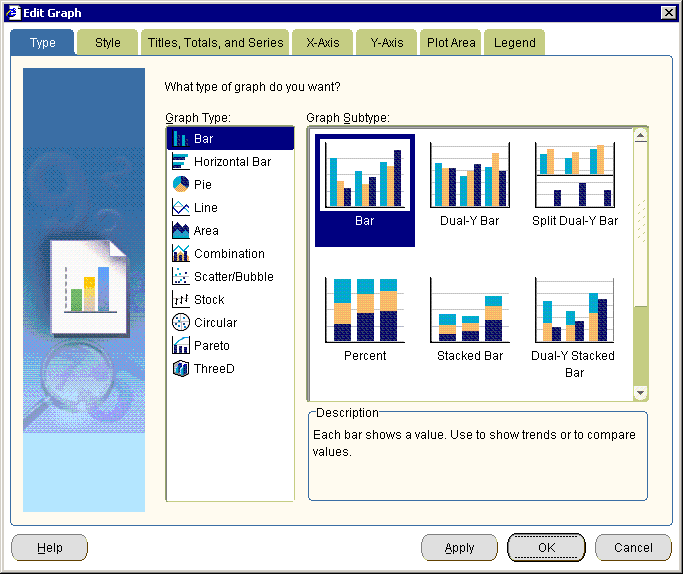
For more information about choosing a graph type, see "About graph types available in Discoverer".
Note: If the worksheet contains a graph that is hidden (that is, the Graph check box is cleared in the View menu), Discoverer displays the Edit Graph dialog, which enables you to edit the graph.
Display the "Edit Graph dialog: Style tab", which enables you to select a graph style.
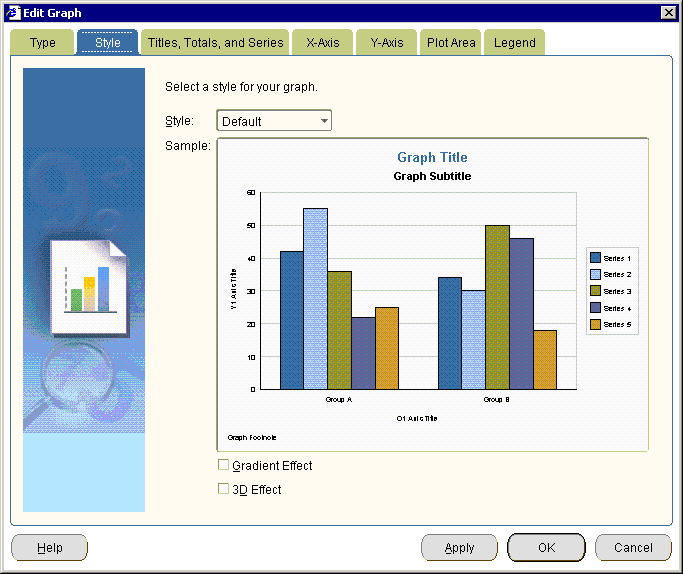
A graph style is a predefined set of colors and text styles that Discoverer applies to the graph. For example, Default, Autumn, Financial, Black and White.
Display the "Edit Graph dialog: Titles, Totals, and Series tab", where you:
(optional) define a graph title
use the What would you like to display? options to select what data you want to display (that is, data only, totals only, or both data and totals)
use the Graph series by options to select whether to plot data by row or column
(optional) when creating a pie graph, select which row or column you want to plot on the graph
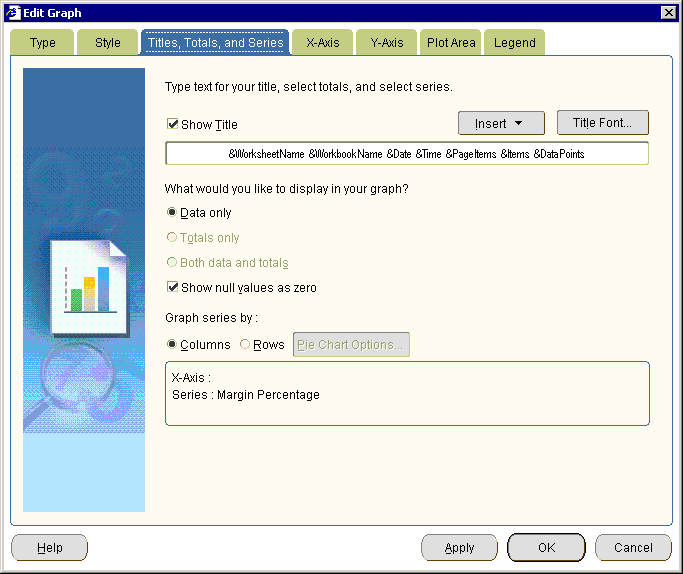
If you are creating a pie graph, the Pie Chart Options button is active.
(optional) If you are creating a Pie Chart, select the column or row you want to plot on the graph, as follows:
Click Pie Chart Options to display the "Edit Graph dialog: Pie Chart Options tab (column)" or "Edit Graph dialog: Pie Chart Options tab (row)".
Select the row or column you want to graph from the list of items.
Click OK.
Note: When you click Next, you go straight to the "Edit Graph dialog: Legend tab". You do not define X or Y axes for pie graphs.
Display the "Edit Graph dialog: X-Axis tab", where you specify how the X axis is displayed.
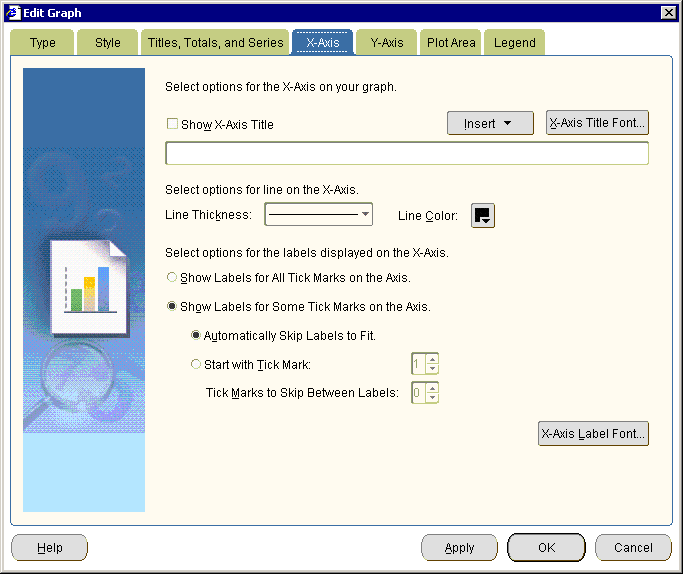
Display the "Edit Graph dialog: Y-Axis tab", where you specify how the Y axis is displayed.
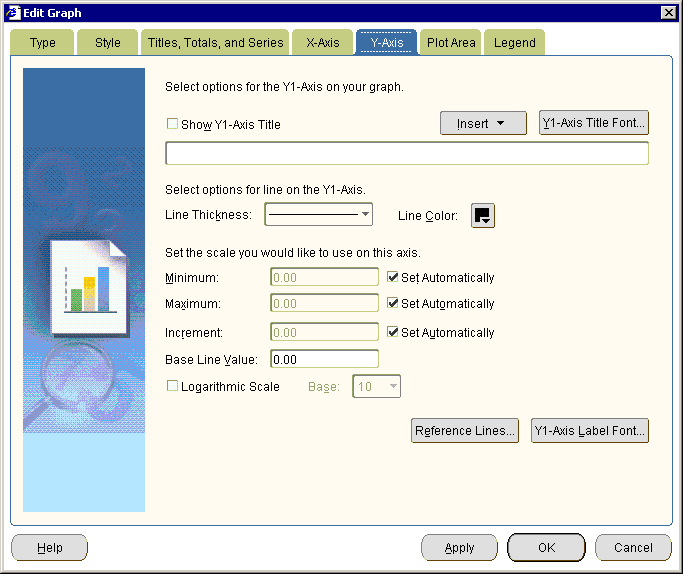
(optional) If you are creating a dual-Y graph, display the "Edit Graph dialog: Y2-Axis page (on dual-Y type graphs)", where you specify how the Y-2 axis is displayed.
For more information about creating dual-Y graphs, see "Notes about creating dual-Y graphs".
Display the "Edit Graph dialog: Plot Area tab", where you specify the color and style of plotted data.
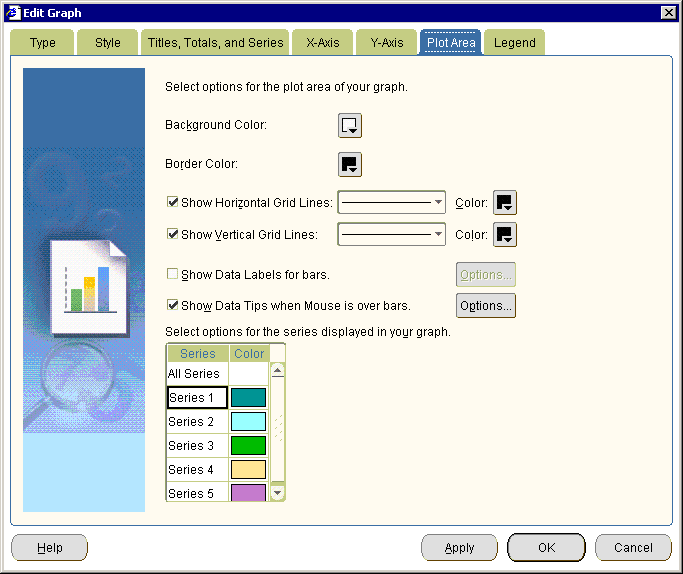
Display the "Edit Graph dialog: Legend tab", where you specify the graph legend that provides information about how items are represented on the graph.
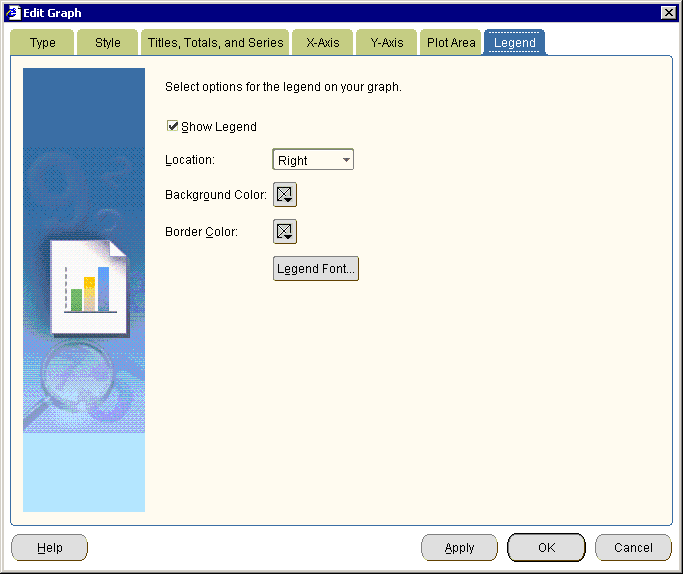
Click the Finish button to save the details and display the graph.
Discoverer displays the graph on the worksheet. By default, graphs are displayed at the right-hand side of worksheet data. To change where a graph is displayed, choose View | Graph Placement and choose a position from the list of options.
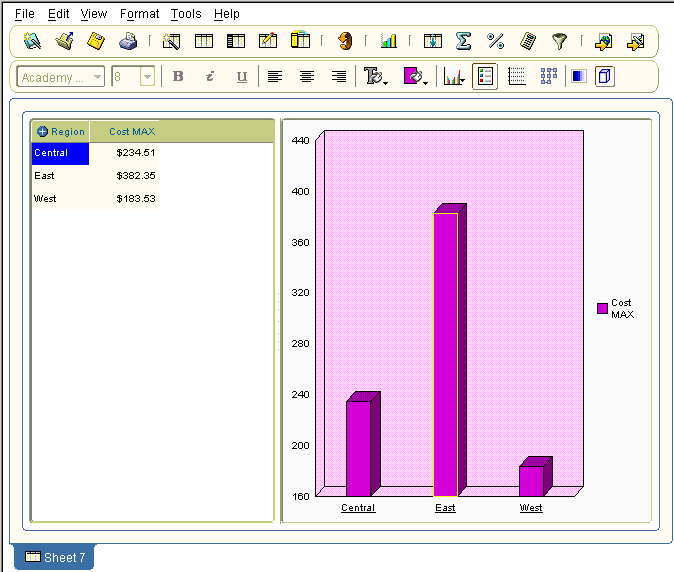
Notes
To automatically arrange graph components, right-click on the graph border and choose Auto Layout.
You hide a graph when you no longer need it. You display a graph when you want to display worksheet data visually or edit a graph.
Note: Hiding a graph does not remove the graph from the worksheet. You can always display the graph later if required.
To hide or display a graph:
Display the worksheet that contains the graph.
Choose View to display the View menu, and do one of the following:
Select the Graph check box to display the graph for the current worksheet
If this option is grayed out, to create a graph choose Edit | Graph to display the Edit Graph dialog.
Clear the Graph check box to hide the graph for the current worksheet
Discoverer updates the worksheet with the changes that you specify.
You change the position of a graph when you want to change where it is displayed in relation to the worksheet data. For example, you might want to display a graph below worksheet data, or display a graph in a separate window.
To position a graph:
Choose View | Placement and choose one of the placement options.
For example, choose the Graph below Table/Crosstab option to position the graph beneath the data, or choose Separate Window to display the graph in a separate window.
Discoverer displays the graph in the position that you specified.
Notes
When you change the position of a graph, you change how the graph is positioned on screen. This does not affect how a worksheet and graph prints. For example, Discoverer always prints graphs on a separate page, after the worksheet data.
If you use Discoverer Viewer or Oracle Portal to publish worksheets, Discoverer Viewer and Oracle Portal display worksheet graphs above or below worksheet data.